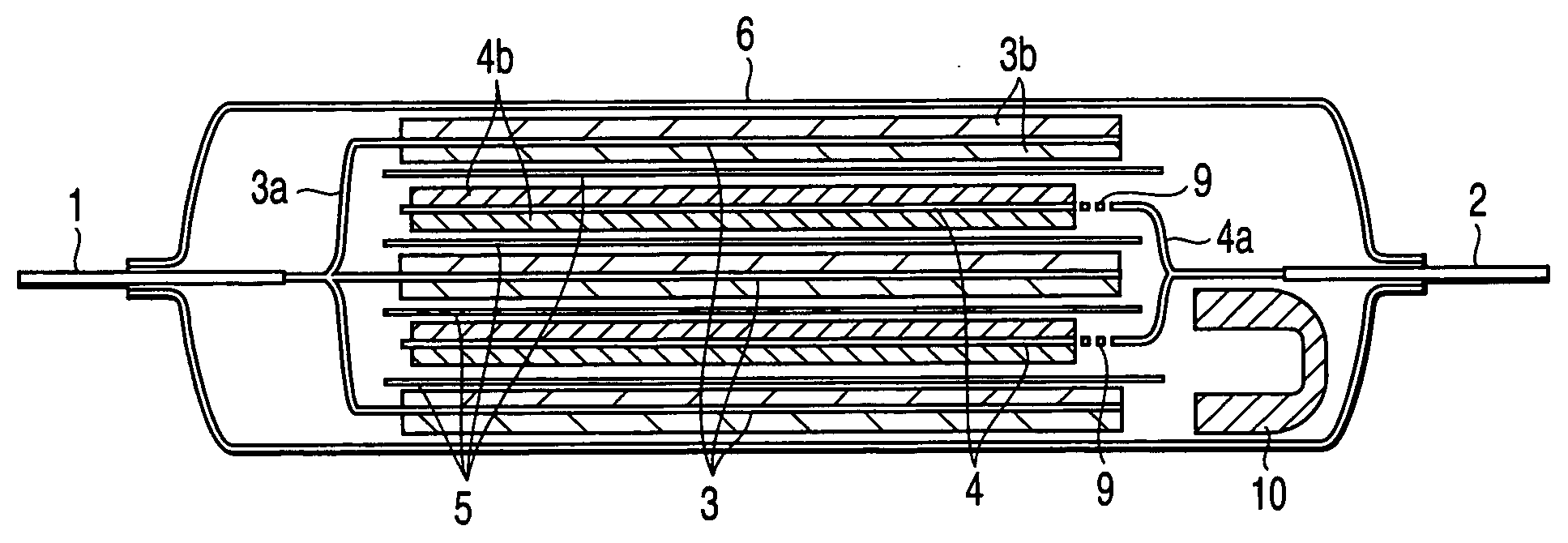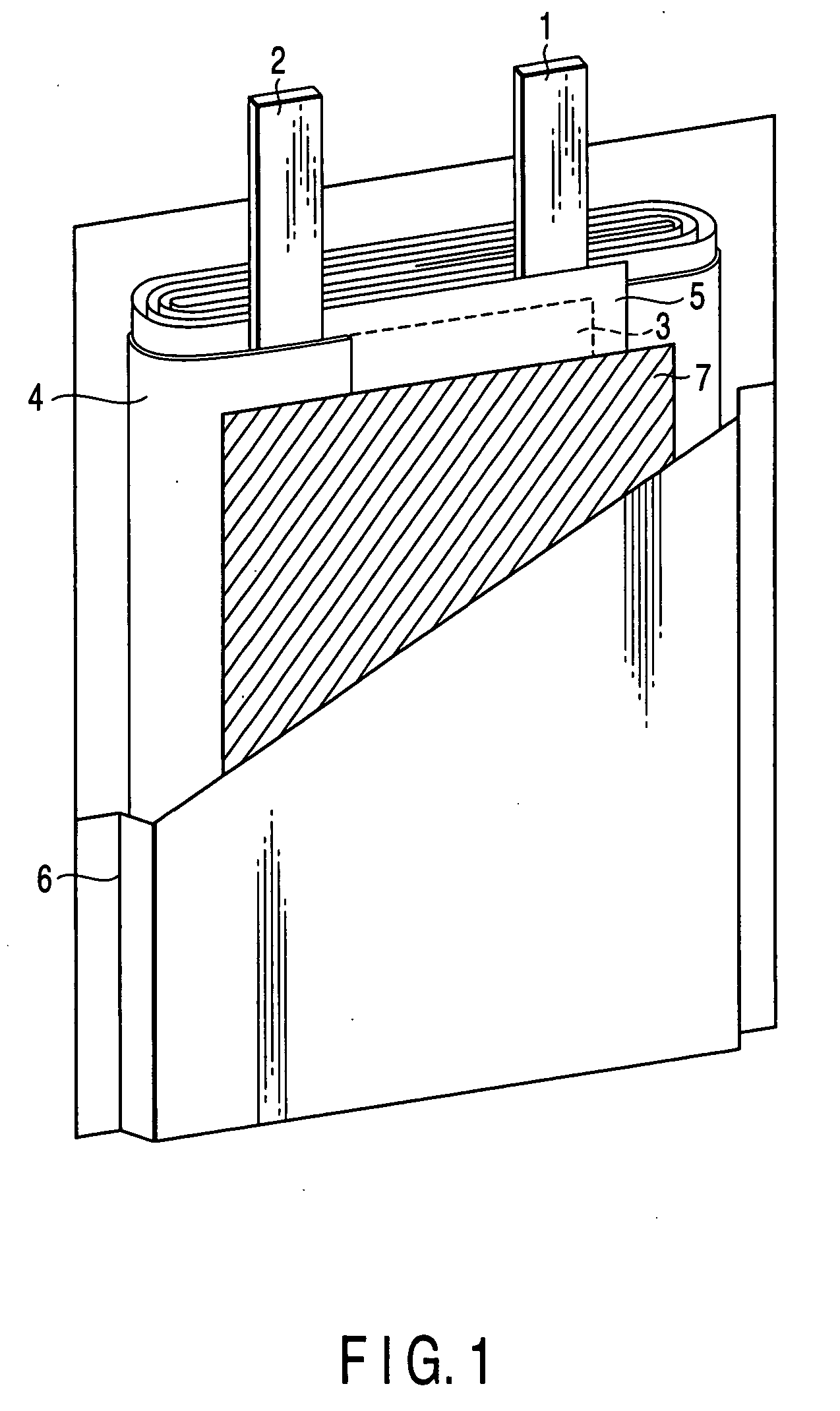Nonaqueous electrolyte secondary battery
a secondary battery and non-aqueous electrolyte technology, applied in the direction of batteries, sustainable manufacturing/processing, cell components, etc., can solve the problems of affecting the performance of the secondary battery, etc., to achieve the effect of high safety
- Summary
- Abstract
- Description
- Claims
- Application Information
AI Technical Summary
Benefits of technology
Problems solved by technology
Method used
Image
Examples
first embodiment
[0132] A nonaqueous electrolyte secondary battery comprising a wound type electrode group will now be described. In the nonaqueous electrolyte secondary battery described in the following, a thermally shrinkable resin tape is used for convenience as the stress imparting member for imparting a tensile stress or a shearing stress.
[0133]FIG. 1 is an oblique view, partly broken away, schematically showing the construction of a nonaqueous electrolyte secondary battery, which comprises a wound type electrode group, according to the first embodiment of the present invention. As shown in FIG. 1, the electrode group is prepared by spirally winding a laminate structure including a positive electrode 3, a negative electrode 4 and a separator 5 interposed between the positive electrode 3 and the negative electrode 4. The laminate structure noted above is spirally wound such that the negative electrode 4 is positioned to constitute the outermost layer of the laminate structure and that the woun...
second embodiment
[0148] A nonaqueous electrolyte secondary battery comprising a laminate type electrode group will now be described. In this embodiment, the stress imparting member for imparting a tensile stress or a shearing stress is formed of a spring, for convenience.
[0149]FIG. 6 is a plan view schematically showing the construction of one of the electrode groups included in a laminate type nonaqueous electrolyte secondary battery according to a second embodiment of the present invention. FIG. 7 is a cross sectional view schematically showing the construction of the laminate type nonaqueous electrolyte secondary battery comprising electrode group shown in FIG. 6. Shown in this drawing is the battery under the state before operation of the current stopping mechanism. For convenience, the portion concealed by the upper layer is denoted by dotted lines. As shown in FIG. 6, the positive electrode 3 having an area smaller than that of the separator 5 is arranged on one surface (back surface in FIG. ...
example 1
[0160] A slurry was prepared by dispersing lithium-cobalt oxide (LiCoO2) used as a positive electrode active material, a graphite power used as a conductive agent, and polyvinylidene fluoride (PVdF) used as a binder in an n-methylpyrrolidone (NMP) used as a solvent in a weight ratio of 87:8:5. Then, an aluminum foil having a thickness of 15 μm and a purity of 99.99% was coated with the slurry thus prepared, followed by drying and, then, pressing the aluminum foil coated with slurry so as to obtain an oblong positive electrode sized at 51 mm×470 mm and having an electrode density of 3.5 g / cm3.
[0161] On the other hand, another slurry was prepared by dispersing lithium titanate (Li4Ti5O12) having an average particle diameter of 0.5 μm, which was used as a negative electrode active material, a carbon powder having an average particle diameter of 0.4 μm, which was used as a conductive agent, and PVdF used as a binder in an n-methylpyrrolidone (NMP) solvent in a weight ratio of 90:7:3. T...
PUM
| Property | Measurement | Unit |
|---|---|---|
| lithium electrode potential | aaaaa | aaaaa |
| operating temperature | aaaaa | aaaaa |
| operating temperature | aaaaa | aaaaa |
Abstract
Description
Claims
Application Information
 Login to View More
Login to View More - R&D
- Intellectual Property
- Life Sciences
- Materials
- Tech Scout
- Unparalleled Data Quality
- Higher Quality Content
- 60% Fewer Hallucinations
Browse by: Latest US Patents, China's latest patents, Technical Efficacy Thesaurus, Application Domain, Technology Topic, Popular Technical Reports.
© 2025 PatSnap. All rights reserved.Legal|Privacy policy|Modern Slavery Act Transparency Statement|Sitemap|About US| Contact US: help@patsnap.com



